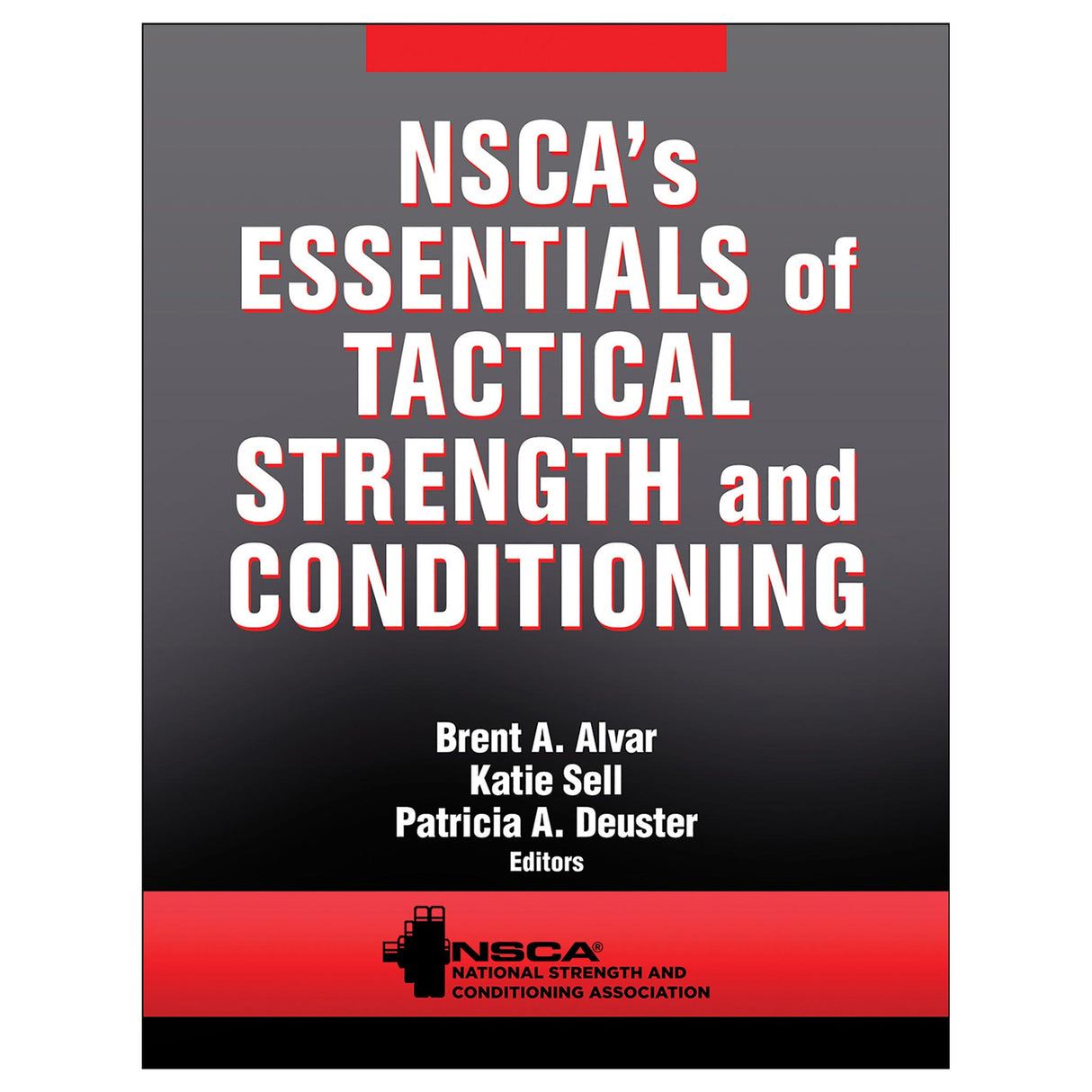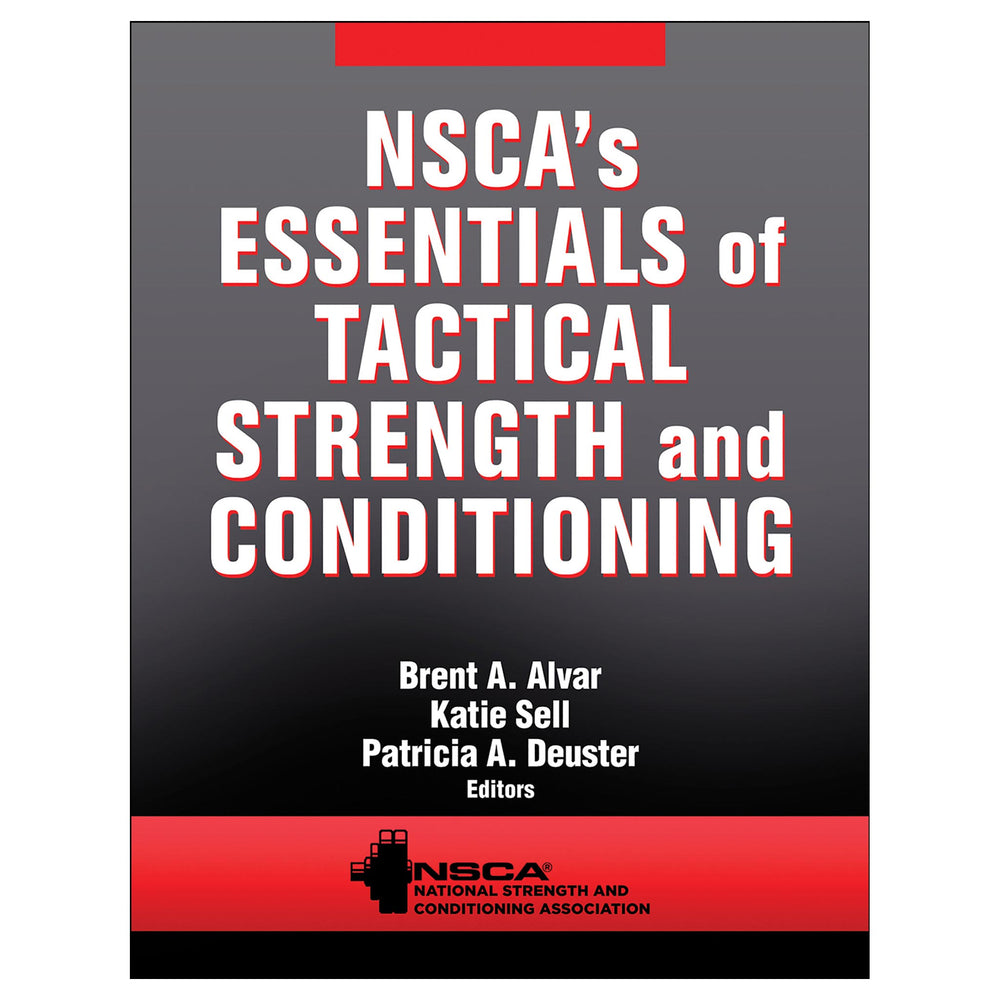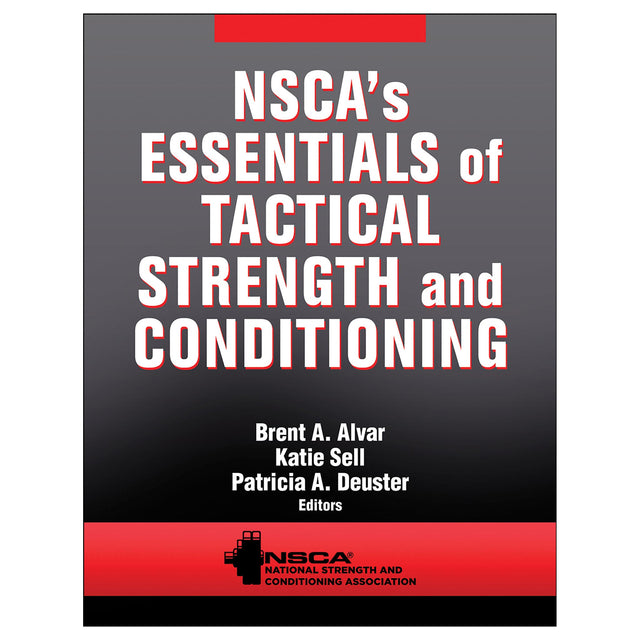NSCA's Essentials of Tactical Strength and Conditioning
$99.00 USD
The physical demands of tactical professions such as military, law enforcement, and fire and rescue require those workers to be in top physical condition to perform their jobs well and decrease the risk of injury. NSCA’s Essentials of Tactical Strength and Conditioning contains scientific information to assist in implementing or restructuring strength and conditioning programs at commercial or government fitness centers that work with these tactical athletes to achieve those goals.
Designed primarily as a preparatory resource for the National Strength and Conditioning Association (NSCA) Tactical Strength and Conditioning Facilitator (TSAC-F) certification, the text is also useful as a manual for government agencies or a daily reference for strength and conditioning professionals. Editors Brent A. Alvar, Katie Sell, and Patricia A. Deuster have extensive experience as scholars and practitioners in their respective fields. They have assembled a team of distinguished contributors who bring to light current trends in strength and conditioning through their combined experiences as professionals in the fields of academia, athletic training, firefighting, law enforcement, military, nutrition, physical therapy, and strength and conditioning.
The contributors not only provide foundational knowledge of exercise physiology and biomechanical movement patterns, but they also comprehensively review all of the components necessary for TSAC Facilitators to design and operate successful training programs for tactical athletes. Separate chapters focus on the specific physiological issues related to military, law enforcement, and fire and rescue personnel, including how a strength and conditioning program should directly correlate to their critical job tasks and the specific environmental, occupational, and exposure concerns for each population.
Topics such as nutrition, supplements, injury treatment and rehabilitation, wellness interventions, and assessments and evaluations are discussed for professionals who work with tactical populations. Additionally, exercises, drills, and techniques targeting the specific needs of tactical athletes in areas such as flexibility, mobility, speed, agility, power, and aerobic endurance are described in great detail and accompanied by full-color photos.
Each chapter of NSCA’s Essentials of Tactical Strength and Conditioning begins with learning objectives and incorporates key terms, diagrams, detailed photographs, and key points throughout the text to help guide readers and facilitate comprehension of concepts. Sidebars and sample programs are included in some chapters to help readers apply theoretical concepts in their professional practice.
Additionally, for instructors using the book, or the TSAC-F exam prep symposia, a presentation package plus image bank with more than 300 photos and illustrations is available, making preparation easier with the use of predeveloped materials that correspond with the book’s content.
Ultimately, the goal of NSCA’s Essentials of Tactical Strength and Conditioning is to help prepare those seeking TSAC-F certification and to serve as a resource for professionals so that they can implement an optimal strength and conditioning program targeted for tactical athletes that will decrease their risk of injury and optimize performance.
Audience
Preparatory guide for those seeking to obtain National Strength and Conditioning Association (NSCA) Tactical Strength and Conditioning Facilitator (TSAC-F) certification. Also an applied reference book for health and wellness professionals who work with tactical populations such as military, law enforcement, and fire and rescue personnel.
Chapter 1: Tactical Strength and Conditioning: An Overview
Brent A. Alvar, PhD, CSCS,*D, RSCC*D, FNSCA
Katie Sell, PhD, CSCS,*D, TSAC-F
Patricia A. Deuster, PhD, MPH, CNS
NSCA TSAC Program
Duties of a Tactical Athlete
Job Analysis of a Tactical Athlete
Assessment of the Individual
Program Design
Chapter 2: Cardiopulmonary and Endocrine Responses and Adaptations to Exercise
Denise Smith, PhD
Cardiovascular Structure and Function
Pulmonary Anatomy and Function
Acute Cardiovascular Responses to Exercise
Acute Respiratory Responses to Exercise
Acute Endocrine Responses to Exercise
Chronic Adaptations of the Cardiopulmonary and Endocrine Systems to Exercise and High-Stress Situations
Chapter 3: Skeletal Muscle Anatomy and Biomechanics
Michael R. Deschenes, PhD
Raymond W. McCoy, PhD
Bones and the Skeleton
Skeletal Muscle
Muscle Mechanics
Neuromuscular Anatomy
Neural Responses During Exercise
Biomechanical Principles
Types of Muscle-Strengthening Exercises
Biomechanical Factors Affecting Muscle Strength
Chapter 4: Physiological Adaptations and Bioenergetics
Todd Miller, PhD, CSCS,*D, TSAC‐F, FNSCA
Bioenergetics and Metabolism
Physiological Adaptations to Exercise
Detraining and Retraining
Chapter 5: Basic Nutrition for Tactical Populations
Steve Hertzler, PhD, RD, LD
Amanda Carlson-Phillips, MS, RD, CSSD
Guidelines for Dispensing Nutrition Information
Step 1: Understand the Demands of the Tactical Athlete
Step 2: Understand Basic Fueling Concepts
Step 3: Provide Nutritional Guidance
Step 4: Create Nutritional Recommendations to Support Performance and Recovery
Providing Guidance on Energy Balance and Nutrition Tools
Chapter 6: Tactical Fueling
Maj. Nicholas D. Barringer, PhD, RD, CSCS,*D, CSSD
Maj. Aaron P. Crombie, PhD, RD
Nutritional Needs of Tactical Athletes
Nutrient Requirements of Tactical Athletes Under Various Conditions
Nutrition-Related Conditions and Chronic Diseases of Tactical Athletes
Chapter 7: Ergogenic Aids
Abbie E. Smith-Ryan, PhD, CSCS,*D, FNSCA
Colin D. Wilborn, PhD, CSCS, ATC
Eric T. Trexler, MA, CSCS
Regulation of Dietary Supplements
Anti-Doping Agencies and Dietary Supplement Resources
Risk Stratification of Supplements
Common Performance-Enhancing Substances: Potential Benefits, Risks, and Side Effects
Illegal Performance-Enhancing Substances
Signs and Symptoms of Ergogenic Aid Abuse
Chapter 8: Testing and Evaluation of Tactical Populations
Bradley J. Warr, PhD, MPAS
Patrick Gagnon, MS
Dennis E. Scofield, MEd, CSCS
Suzanne Jaenen, MS
History of Fitness Testing in Tactical Occupations
Types of Performance Tests
Testing Procedures
Evaluation of Performance Test Results
Use of Performance Test Results
Chapter 9: Development of Resistance Training Programs
Nicholas A. Ratamess, PhD, CSCS,*D, FNSCA
Needs Analysis
Resistance Training Program Design
Chapter 10: Periodization for Tactical Populations
G. Gregory Haff, PhD, CSCS,*D, FNSCA, ASCC
Defining Periodization
Goals of Periodization
Principles of Periodization Models
Structural Components of Periodized Training
Sequencing and Integrating Training
Applying Periodization Theory to Deployment-Based Tactical Athletes
Applying Periodization Theory to Nondeployed Tactical Athletes
Chapter 11: Resistance Training Exercise Techniques
Jason Dudley, MS, CSCS,*D, TSAC‐F, RSCC, FMS‐1, USAW‐1
Brad Schoenfeld, PhD, CSCS, NSCA‐CPT, FNSCA
Performing Exercises With Alternative Implements
Warm-Up Before Resistance Training
Guidelines on Body Stance and Alignment, Breathing, and Spotting
Resistance Training Exercises
Chapter 12: Flexibility and Mobility Exercise Techniques and Programming
Mark Stephenson, MS, ATC, CSCS,*D, TSAC-F
Daniel J. Dodd, PhD, CSCS
Comparison of Mobility and FlexibilityTypes of Flexibility and Mobility Exercises
Exercise Technique and Cueing Guidelines
Program Design
Chapter 13: Plyometric, Speed, and Agility Exercise Techniques and Programming
Mike Barnes, MEd, CSCS, NSCA‐CPT
Jay Dawes, PhD, CSCS,*D, NSCA‐CPT,*D, FNSCA
Plyometric Training
Speed Training
Agility Training
Chapter 14: Aerobic Endurance Exercise Techniques and Programming
Matthew R. Rhea, PhD, CSCS,*D
Brent A. Alvar, PhD, CSCS,*D, RSCC*D, FNSCA
Warming Up Before Aerobic Endurance Training
Exercise Techniques and Cueing Guidelines
Step 1: Exercise Mode
Step 2: Training Frequency
Step 3: Training Intensity
Step 4: Exercise Duration
Step 5: Exercise Progression
Program Design Recommendations
Chapter 15: Evidence-Based Approach to Strength and Power Training to Improve Performance in Tactical Populations
Dennis E. Scofield, MEd, CSCS
Sarah E. Sauers, MS, CSCS
Barry A. Spiering, PhD, CSCS
Marilyn A. Sharp, MS
Bradley C. Nindl, PhD
Overview of Occupational Demands
Optimizing Occupational Performance
Applying Principles of Strength and Power Training
Chapter 16: Care and Rehabilitation of Injured Tactical Populations
Danny McMillian, PT, DSc
Common Injury Prevalence and Risk Factors
Phases of Tissue Healing
Causes, Signs, and Symptoms of Overtraining Syndrome
Maintenance of Training Status During Rehabilitation and Reconditioning
Guidelines for Injury Care and Rehabilitation
Chapter 17: Physiological Issues Related to Fire and Rescue Personnel
Katie Sell, PhD, CSCS,*D, TSAC-F,*D
Mark Abel, PhD, CSCS,*D, TSAC-F,*D, USAW
Joseph Domitrovich, PhD
Critical Job Tasks for Firefighters
Environmental, Occupational, and Exposure Concerns
Injury and Illness Risks in Firefighters
Optimizing Functional Fitness
Program Design and Sample Training Approaches
Chapter 18: Physiological Issues Related to Law Enforcement Personnel
Ben Hinton, MSc, CSCS
Sgt Mick Sterli, BPhysEd, MExSc, CSCS,*D, TSAC‐F,*D
Robin Orr, PhD, MPhty, BFET, TSAC-F
Critical Job Tasks for Law Enforcement Personnel
Environmental, Occupational, and Exposure Concerns
Injury and Illness Risks
Optimizing Functional Fitness
Key Program Variables
Chapter 19: Physiological Issues Related to Military Personnel
William Kraemer, PhD, CSCS,*D, FNSCA
LTC David Feltwell, PT, OCS, TSAC-F
Tunde Szivak, PhD, CSCS
Critical Job Tasks for Conventional Military and Special Operations Personnel
Environmental, Occupational, and Exposure Concerns
Injury and Illness Risks
Optimizing Functional Fitness
Program Design and Sample Training Approaches
Chapter 20: Physical Training to Optimize Load Carriage
Paul C. Henning, PhD, CSCS
Barry A. Spiering, PhD, CSCS
Dennis E. Scofield, MEd, CSCS
Bradley C. Nindl, PhD
Impact of Equipment Load on Biomechanical Demands
Physiological and Biomechanical Demands of Load Carriage
Practical Considerations for Training Programs to Optimize Load Carriage
Chapter 21: Wellness Interventions in Tactical Populations
Robin Orr, PhD, MPhty, BFET, TSAC-F
John R. Bennett, MS, CSCS, EMT-P
Chronic Illness and Diseases Conditions Common in Tactical Populations
Risk Factors Requiring Wellness Interventions
Operating Wellness Programs for Tactical Populations
Chapter 22: Organization and Administration Considerations
John Hofman, Jr, MS, CSCS, USAW, USA T&F, FMS
Frank A. Palkoska, MS, CSCS
Design
Layout and Organization
Policies and Procedures
Safe Training Environment
About the NSCA
The National Strength and Conditioning Association (NSCA) is the world’s leading organization in the field of sport conditioning. Drawing on the resources and expertise of the most recognized professionals in strength training and conditioning, sport science, performance research, education, and sports medicine, the NSCA is the world’s trusted source of knowledge and training guidelines for coaches, athletes, and tactical operators. The NSCA provides the crucial link between the lab and the field.
About the Editors
Brent A. Alvar, PhD, CSCS,*D, RSCC*D, FNSCA, is a professor of health science at Rocky Mountain University of Health Professions. He is a certified strength and conditioning specialist with distinction, registered strength and conditioning coach with distinction, and a fellow of the NSCA. Alvar was named the NSCA’s Educator of the Year in 2016 and is a past member of the NSCA Board of Directors.
At Rocky Mountain University, Alvar served as the director, the associate dean and vice president of university research, the concentration track director for the doctoral program in Human & Sport Performance, and the codirector of the graduate program in health promotion and wellness. Alvar also served as the sport performance director and faculty member at Chandler Gilbert Community College while simultaneously having an appointment as an assistant research professor in the department of exercise and wellness at Arizona State University, where he earned his bachelor’s, master’s, and doctoral degrees. Alvar’s primary research focus is in the area of physical activity related to human performance and occupational preparedness as well as the muscular strength and health-related benefits from resistance training.
Katie Sell, PhD, CSCS,*D, TSAC-F, ACSM EP-C, is an associate professor and coordinator of the undergraduate exercise science program in the department of health professions at Hofstra University. Her NSCA certifications include being a certified strength and conditioning specialist with distinction and a tactical strength and conditioning facilitator. She is also an exercise physiologist certified with the American College of Sports Medicine (ACSM).
Sell has been a volunteer assistant coach for the Hofstra women’s tennis program, a member of the NSCA Tactical Strength and Conditioning Special Interest Group Executive Council, and a consultant to FireFit, which is an interagency wildland firefighter fitness task group. She serves as a physical fitness standards and programming consultant with various professional firefighting departments in the Salt Lake City, Utah, region.
Sell’s primary research interests are in the areas of physical activity promotion among college students and firefighter health, physical fitness, and exercise programming. She received her doctoral degree from the University of Utah, her master’s degree from Southern Illinois University, and her bachelor’s degree from the University of Tennessee at Martin.
Patricia A. Deuster, PhD, MPH, CNS, is a professor in the department of military and emergency medicine at the Uniformed Services University of the Health Sciences (USU) and director of the Consortium for Health and Military Performance (CHAMP), the Defense Center of Excelleence in the area of human performance optimization. A certified nutrition specialist and fellow of the American College of Sports Medicine (ACSM), Deuster is a coauthor of The Navy SEAL Nutrition Guide and The Special Operations Forces Nutrition Guide and the editor of The Navy SEAL Physical Fitness Guide.
Deuster received the Special Operations Medical Researcher Award in 2014 by the Special Operations Medical Association. She is a member of the Order of Military Medical Merit and has served the Department of Defense on its Dietary Supplement Subcommittee, Food and Nutrition Subcommittee, Human Performance Optimization Committee, Population Health Working Group, and Operational Supplement Safety Initiative.
Deuster received her bachelor’s and master’s degrees from the College of William and Mary, her PhD from the University of Maryland, and her MPH from USU. Among her athletic achievements, she has been a tennis professional, nationally ranked marathoner, and qualifier for the first women’s marathon Olympic Trials in 1984.
Nutrient Needs During Deployment and Shift Work
Program Design and Sample Training Approaches



All ancillaries are free to adopting instructors through HKPropel.
Presentation package plus image bank. Includes almost 900 PowerPoint slides of text, photos, artwork, and tables from the book that instructors can use for discussion and illustration. The slides in the presentation package can be used directly in PowerPoint or can be printed to make transparencies or handouts for distribution. Presenters can easily add, modify, and rearrange the order of the slides as well as search for slides based on key words. The image bank includes all of the illustrations, artwork, content photos, and tables from the text, sorted by chapter to provide instructors with flexibility when creating their own resources, including customized presentations, handouts, and other resources.




